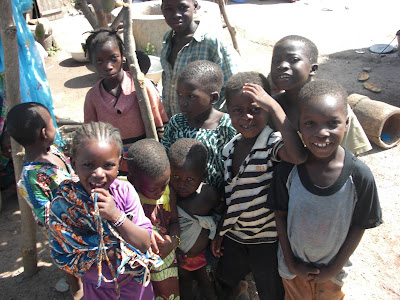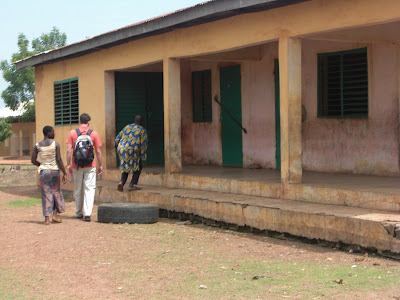----------------------------------------------------------------------------------------
Damian: I'll never get over how many children there are in Africa. Hopefully Brangelina will adopt a few more and maybe Madonna will consider another. Bad jokes aside there are a lot of children in Africa that need everything from pencils and khakis for school to medicine and food for nutrition. The task is so daunting that it's easy to get discouraged if one thinks to long about it. We were immediately swarmed by children upon entering the village. It's easy to spot children that come from 'wealthier' families because they're dressed nicer. The very poor children come from homes where the father most likely works the fields and the mother sells things at the market. The poverty is instantly visible. I read Becky's entry below and she wrote about donated clothes being resold or stolen at the port. This does occur. Parakou, the largest City in northern Benin, had a place that we called the 'dead yovo' store. I'm not sure if it was ever confirmed but many of us suspected that these western clothes being sold at the market were meant to be donated not sold. It was always funny/odd to see a child wearing a shirt with the following print: "DON'T BOTHER ME I'M ON VACATION". Becky and I saw a child in Barei with a "Vote for Pedro" t-shirt...good stuff.
Becky: There are so many kids in this village. Families tend to have a lot of children. Our host, Taffa, had six children himself of a very wide age range. For example, his youngest son, Marouf, is just six years old, but he is an uncle to a teenager, the daughter of Taffa's oldest daughter. So there are just going to be a lot of photos here of kids around Barei. They'd follow us around wherever we walked. This village is a few kilometers outside of Djougou, where Damian was a teacher, but it is the home of his friend Taffa so he spent a lot of time there as a Peace Corps volunteer. I was really impressed by the enormous cultural difference between these isolated villages like Barei and major cities like Cotonou. Cotonou has a lot of Western influence... you'd see girls in skirts just to the knee, in pants like jeans, and some pretty nice houses for the wealthy, with electricity, cars, etc., just like we have here.
But in the villages, it was like going back in time a couple hundred years. The poverty is evident. People's day-to-day routine is based around survival - fetching water for the cooking and cleaning, getting food for the family meals, etc. The people have very little in terms of material possessions. Damian told me the clothes the kids wear were so ragged because sometimes a kid will wear the same tee shirt year round. I was also disheartened to learn that a lot of the donation agencies like Red Cross end up getting corrupt on the receiving end - clothes that are supposed to be free end up being resold. I definitely plan on trying to send more clothes to Barei.













Scars
------------------------------------------------------------------------------------------
Damian: In the past certain tribes in Benin [and other parts of Africa] used facial scaring to visibly demonstrate that an individual was part of a tribe and in other instances the scarring would also indicate certain status. For example, the Fon, Mina, Dendi, Yom, Ditamari and Bariba [just to name a few] would all have very different and distinct facial scarrings. It's very important to note that was more a practice of the past and the Beninois are slowly weaning this cultural practice out of modern day life.
Becky: This small child had one of the more prominant markings... the scar made right down the center of her forehead. Damian told me they make these cuts on their faces when they are infants, using a razor (sterilized with a flame) and then back in the wound with Pate (mashed "corn") and charcoal. These markings can range from barely noticeable to covering the whole face.
Foreign Object
---------------------------------------------------------------------------------
Damian: White girl!!! There's a french woman whom I think still lives in Djougou. I'm sure the children of Barei see her in her car as she whizzes from Togo to Djougou. And I know that there is a large group of Italians that visit Barei perinnially. So in this instance the kids also get a close up view of white people. It's not often that they're able to have hands on contact with their very own white person. It's like a doll! :) Taffa teased some of the much younger kids telling them that we were going to take them back to the United States with us...they were mortified--I've have no doubt that they'd be less scared come this November. :)
Becky: Because Barei is so isolated, white people are a rare sight. Some of the youngest children, infants barely able to walk, cried when they saw us. I'm sure to them we must look like people who don't have skin. There is one excerpt in the novel the Poisonwood Bible (by Barbara Kingsolver) where a white American family goes on a mission in the Congo, and one of the local kids tells the American kids that they were white because they "didn't finish cooking" in the womb. Some of the braver kids came up and patted my hair... the texture was new and unusual for them, too. Sometimes Damian would jump up all of the sudden and make like he was going to chase them, and they'd run screaming in all directions. It was a fun way to pass the time.

 Entertainment
Entertainment-----------------------------------------------------------------------------
Damian: Kids will play with your trash. If you're moving to Africa remember that. Everything you throw out will most likely end up on a kid's head...everything.
Becky: One of the most common toys is an old tire and stick, that the kids run alongside the ground with. The little boy in this picture is holding one over his head. The kids also went crazy for the stuff you'd never expect: our straws from drinking a soda (they'd suck more of the sweet outside of the straw), looking at their digitalized image on the back of my camera after I took a picture, and making "cootie-catchers". I tried to teach hop-scotch, but that didn't seem to catch on at all.

Kwashiorkor
----------------------------------------------------------------------------------
Damian:
Becky: The nutrition the kids get is far from perfect. There is definitely evidence of protein malnutrition in the kids everywhere I looked. Meat is really expensive. The kids are raised on a diet of mainly Pile (the mashed root vegetable resembling potatoes) and wagasi, a cheese. But when you don't get enough protein, your abdominal muscles aren't able to develop properly and the weight of your abdominal contents (i.e. your intestines) pushes out, hence the big bellies.



Baptism
-------------------------------------------------------------------------------------
Damian:
Becky: One day while wandering around the village we came upon a big celebration. A family was baptizing their baby. They let us join in the festivities for a little bit. They baptize the baby at one week of age. The orange stuff on the scalp is supposed to aid in the closing of the skull sutures. The woman in blue appears to be the proud grandmother. The younger woman in green (who looks very tired!) is the mother. I was thrilled they let me hold the baby.






 Education
Education------------------------------------------------------------------------------
Damian:
Becky: Late one morning we walked through the local middle and high school. This is a typical classroom with a lesson on the board (sorry my photo is kind of blurred). The kids all stand up when you walk in and don't sit again until they are told to. I'm so impressed with how well-behaved the kids are, both in school and out and about in the village. The classroom sizes are large, around sixty kids. You can grab any kid you want and send them on an errand for you, even if it is not your kid, and they are expected to do so and do so without complaints. It makes American kids seem really spoiled. They aren't always well behaved, though. If you pull out a bag of balloons in front of the young ones you can expect a small riot. Regardless, the kids were great. The older kids wear uniforms. The pictures below that are of a primary school, where they don't wear uniforms. When we walked in, a couple of the little tykes started crying and ran out of the door. Also pictured is their swing set and playground.
















No comments:
Post a Comment